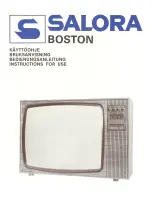
Crestron
CNRFGWA
Wireless
RF
Receiver
Operations Guide - DOC. 8086A
Wireless RF Receiver: CNRFGWA
•
13
Appendix: Optimum RF Reception Guidelines
Many factors can affect the reliability of RF communication between an RF
touchpanel or remote device and an RF gateway. While an effort has been made to
determine operating specifications, some specifications are not constant. RF
Communication can be limited by several factors including but not limited to EMI
(electromagnetic interference), intervening objects, antenna orientation, and receiver
placement. To obtain maximum reliability and performance, some basic rules for
installing RF receivers are listed below.
Minimize Interference
RF reception range can be hindered by spurious EMI noise that may interfere with or
mask the desired frequency thereby reducing useable range. EMI is generated by any
electrical device at various RF noise levels depending on the device. Sources of EMI
include computers, video equipment, digital processors, lighting dimmers, lighting
ballasts, motors or any large AC source. Every effort should be made to separate any
RF transmitter/receiver from these sources of RF noise including Audio Visual
equipment in racks. If a gateway must be installed in an equipment rack, make sure
you have ample separation between the equipment and the gateway.
Gateway Placement
Optimum reception for any RF gateway is obtained by installing the gateway in an
open area or shelf with a clear line of sight (no obstructions between gateway and
touchpanel or wireless remote). Crestron recommends placing the gateway at least
five to six feet high for best results. Avoid placing gateways or touchpanels/remotes
at a low height or on the ground. Placing RF equipment near metal objects, walls,
corners or metal enclosures will compromise RF propagation and reception. Try to
avoid installing gateways in equipment racks, service rooms or electrical closets. For
best results, Crestron recommends that the gateway be placed in the same room that
the touchpanel or remote is located.
Antenna Orientation
The antenna orientation of the Crestron gateway has considerable effect on range and
reliability. Optimum performance is obtained by setting the gateway horizontally
(antenna parallel to the ground) at right angles to the touchpanel. When absolutely
necessary, two alternate orientations are possible–each will be less effective than the
horizontal orientation:
Point the antenna vertically
Point the antenna toward the wireless touchpanel/remote.
Never point the antenna downward. This will decrease range and reliability. Refer to
illustrations on the next page for examples of the different antenna orientations.
NOTE:
RF propagation is best from the sides of the antenna.
Содержание CNRFGWA
Страница 1: ...Crestron CNRFGWA Wireless RF Receiver Operations Guide ...
Страница 4: ......




































